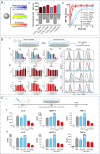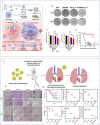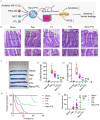Advancements, Challenges, and Future Prospects of Nanotechnology in Sepsis Therapy
- PMID: 40546802
- PMCID: PMC12180596
- DOI: 10.2147/IJN.S488026
Advancements, Challenges, and Future Prospects of Nanotechnology in Sepsis Therapy
Abstract
Sepsis is a life-threatening systemic inflammatory syndrome, typically triggered by infection, that can lead to multi-organ failure and high mortality rates. Traditional treatments for sepsis often have limited efficacy and significant side effects, necessitating the exploration of innovative therapeutic strategies. In recent years, the application of nanotechnology in sepsis therapy has garnered widespread attention due to its potential to modulate immune responses, reduce inflammation and oxidative stress, and eliminate bacterial toxins. This review aims to provide an overview of the latest advancements, challenges, and future prospects of nanotechnology in sepsis treatment. By analyzing recent developments in anti-inflammatory, immunomodulatory, antioxidant, and detoxification applications of nanotechnology, key findings and therapeutic potential are summarized, including the use of nanocarriers, biomimetic nanoparticles, and self-assembled nanomaterials. Furthermore, this review addresses the challenges in clinical translation, such as drug targeting, long-term safety, and biocompatibility. Future research will require large-scale clinical trials and interdisciplinary collaboration to validate the efficacy of nanotechnology in sepsis treatment and facilitate its integration into clinical practice. Overall, nanotechnology presents unprecedented opportunities for sepsis management, and this review seeks to offer insights into ongoing research while promoting further advancements in this field.
Keywords: MODS; nanoimmunotherapy; nanomedicine delivery methods; nanotechnology; sepsis.
© 2025 Liu et al.
Conflict of interest statement
The authors declare that the research was conducted in the absence of any commercial or financial relationships that could be construed as a potential conflict of interest.
Figures













Similar articles
-
Deciphering the therapeutic potential of Sinigrin: A promising anti-inflammatory agent for chronic disease management.Phytomedicine. 2025 Aug;144:156875. doi: 10.1016/j.phymed.2025.156875. Epub 2025 Jun 1. Phytomedicine. 2025. PMID: 40505485 Review.
-
Systemic pharmacological treatments for chronic plaque psoriasis: a network meta-analysis.Cochrane Database Syst Rev. 2021 Apr 19;4(4):CD011535. doi: 10.1002/14651858.CD011535.pub4. Cochrane Database Syst Rev. 2021. Update in: Cochrane Database Syst Rev. 2022 May 23;5:CD011535. doi: 10.1002/14651858.CD011535.pub5. PMID: 33871055 Free PMC article. Updated.
-
Automated monitoring compared to standard care for the early detection of sepsis in critically ill patients.Cochrane Database Syst Rev. 2018 Jun 25;6(6):CD012404. doi: 10.1002/14651858.CD012404.pub2. Cochrane Database Syst Rev. 2018. PMID: 29938790 Free PMC article.
-
Systemic pharmacological treatments for chronic plaque psoriasis: a network meta-analysis.Cochrane Database Syst Rev. 2017 Dec 22;12(12):CD011535. doi: 10.1002/14651858.CD011535.pub2. Cochrane Database Syst Rev. 2017. Update in: Cochrane Database Syst Rev. 2020 Jan 9;1:CD011535. doi: 10.1002/14651858.CD011535.pub3. PMID: 29271481 Free PMC article. Updated.
-
Nanomaterial-based encapsulation of biochemicals for targeted sepsis therapy.Mater Today Bio. 2025 Jul 4;33:102054. doi: 10.1016/j.mtbio.2025.102054. eCollection 2025 Aug. Mater Today Bio. 2025. PMID: 40688672 Free PMC article. Review.
References
Publication types
MeSH terms
Substances
LinkOut - more resources
Full Text Sources
Medical

